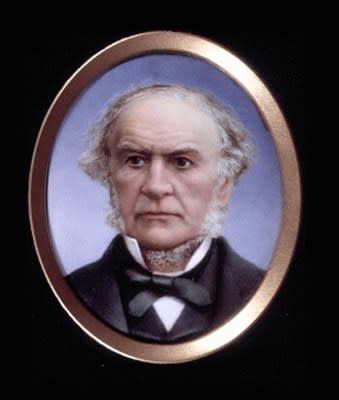
Sidney Carlton Maguire
Enamel Portrait of William Ewart Gladstone (1809-98), 1880
Enamel on copper
1 in. (2.3 cm) high
Inscribed verso: The Right Honble/ W. E . Gladstone Esq./ Painted by S.C. Maguire./ 6 Blomfield Crescent/ Westbourne Terrace/ London./ 1880
Signed ''WGladstone''"
Signed ''WGladstone''"
Philip Mould & Co.
To view all current artworks for sale visit philipmould.com The presence of Gladstone's signature on the counter-enamel of this portrait is a fascinating proof that it derives from a...
To view all current artworks for sale visit philipmould.com
The presence of Gladstone's signature on the counter-enamel of this portrait is a fascinating proof that it derives from a life sitting to Gladstone, and not reproduction after a photograph. It is an exceedingly detailed piece, and reflects the family training that Maguire received from his father, the miniaturist and crayon painter Thomas Maguire (1821-1895) and the inspiration and competition of working alongside his sisters, Adelaide, Helena and Bertha, since all of these artists operated from the same address in Blomfield Crescent.
The enamel has been framed with two further portraits. One is a portrait of John Bright MP (1811-1889), apparently also painted by Maguire, who was a member of Gladstone's government until opposition to the Irish Policy forced him to retire. If he and Gladstone have been seen until 1882 as political stablemates, this resignation might yield a terminus ante quem for their being placed in the same frame. A further, much smaller, miniature beneath these two shows a young woman, though tantalisingly neither her identity nor her relation to the two politicians has been established.
The presence of Gladstone's signature on the counter-enamel of this portrait is a fascinating proof that it derives from a life sitting to Gladstone, and not reproduction after a photograph. It is an exceedingly detailed piece, and reflects the family training that Maguire received from his father, the miniaturist and crayon painter Thomas Maguire (1821-1895) and the inspiration and competition of working alongside his sisters, Adelaide, Helena and Bertha, since all of these artists operated from the same address in Blomfield Crescent.
The enamel has been framed with two further portraits. One is a portrait of John Bright MP (1811-1889), apparently also painted by Maguire, who was a member of Gladstone's government until opposition to the Irish Policy forced him to retire. If he and Gladstone have been seen until 1882 as political stablemates, this resignation might yield a terminus ante quem for their being placed in the same frame. A further, much smaller, miniature beneath these two shows a young woman, though tantalisingly neither her identity nor her relation to the two politicians has been established.
Exhibitions
Royal Academy of Arts, 1881, no. 1310Literature
D. Foskett, A Dictionary of British Miniature Painters, 1972, p. 396Be the first to hear about our available artworks
* denotes required fields
We will process the personal data you have supplied in accordance with our privacy policy (available on request). You can unsubscribe or change your preferences at any time by clicking the link in our emails.